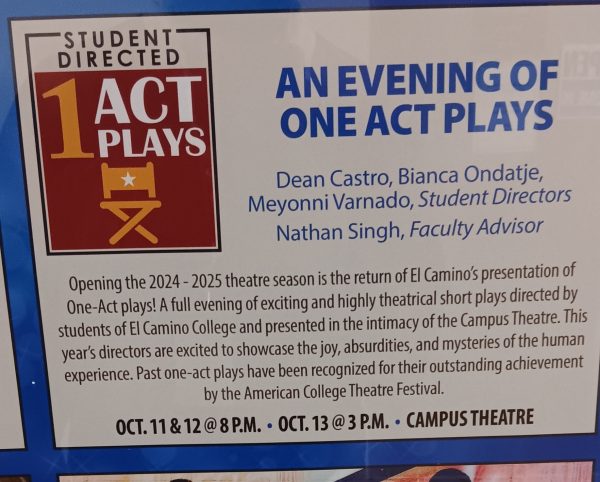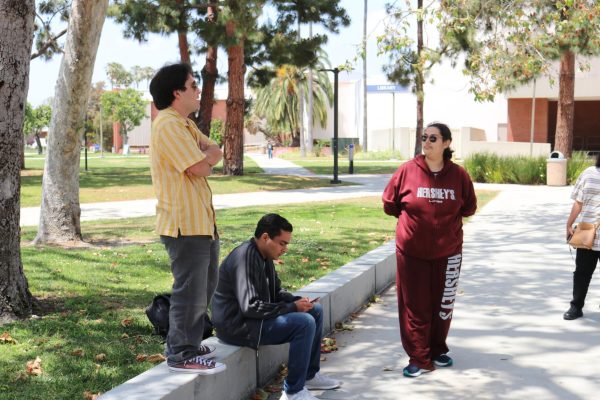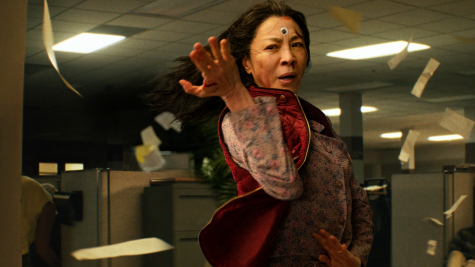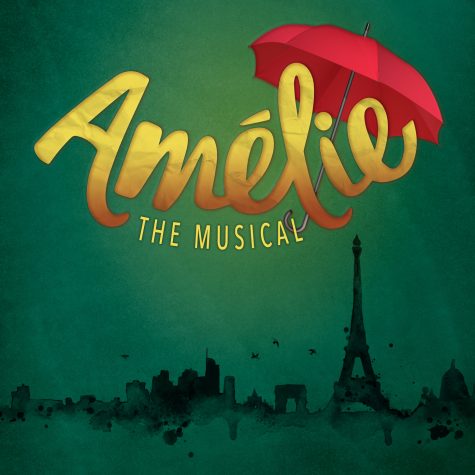Ancient wonders exhibited
Visual proof brings wonders of the ancient past to life in Room 307 of the Arts and Behavioral Sciences Building.
It’s the anthropology exhibit “Early Vietnam: Emporium of the Western Pacific,” displaying items from as far back as 500 B.C. to modern-day Vietnam. All items are being borrowed from a private collector and are worth more than $1 million.
Fine art displayed
“This is one of the most impressive and expensive collections El Camino has ever had,” Dr. Blair Gibson, curator and director of the anthropology museum, said.
Huge items on display include a 6-foot, wood-framed temple bell with “peace on earth” engraved in characters a wooden copper-coated Buddha, and several decorated bronze drums from the Dong Son period, which was over two millennia ago.
“The general theme is that the Vietnamese did have this glorious historic past and (the exhibit) shows the history of Vietnam,” Gibson said.
The exhibit covers all aspects of early Vietnamese life, religious influences, weapons, jewelry and art. Many of the artifacts are at least hundreds of years old and several are thousands of years old.
The museum also includes a colorful map of geographic interests in Vietnam, a chronological guide of the past dynasties and Vietnam’s original creation myth.
“(The exhibit) makes it real. Prior to seeing the artifacts, it was just a theoretical thing,” Christy Abraham, behavioral science major, said.
The anthropology exhibit, which has been around since December of last year, had the first opportunity to display these items before other museums in the area could bid on or show them elsewhere, Gibson said.
Students get involved
The exhibit’s layout was completely set up by Anthropology 28 students, Gibson said, including execution of the design.
It will remain on display in Art B 307 from 9 a.m. to 4 p.m. until Oct.1, when the next exhibit will be set up. The next show will be on spiritual healers from the Los Angeles area as well as Central America, and will include a Santeria segment, Gibson said.
Creating olden marvels
Gibson’s inspiration for the current theme actually came from a visit to a pharmacy. While waiting, he came across an issue of Collector’s Magazine with details about the artifacts in the exhibit.
Upon finding out that the owner lived in Southern California, the opportunity was too great to ignore, Gibson said.
“We would really like people to come and see what is here before it closes,” Gibson said.
The way some of the items were created is very intricate and detailed. The bronze drums, for example, require molds of bronze to be detailed and segmented before the drum can be assembled.
Scholars have argued over what exact material was used to help shape the bronze mold, but they believe that wax or ceramics were used to fill the hollow part and then cracked and removed once the bronze was poured, Gibson said.
“(The drums) are very old. Each drum is a little different and they all show amazing artistic skill; you get a sense of what life was like in Early Vietnam just by looking at the drums,” Gibson said.
A lot of the earlier ceramics were of unpainted terracotta, then fired and painted later.
The Chinese introduced the techniques used to make ceramics more appealing for trade, and thus the glossy look of some of the newer pieces was done by using a three-legged tripod separator and then fired. Pieces that stuck together during the firing process are known as “wasters,” Gibson said.
Old techniques live on
The evolution of Vietnamese art is visible in examples of earthen pots from the earlier dynasties to when the Chinese introduced advanced slipping, glazing and firing techniques.
Ceramic bowls, plates, tea sets and decorative sets were used in everyday life or for trade with other countries. Some ceramic pieces have mythological motifs like dragons or a kylin (a beast made of several animals combined). One plate with Pegasus painted on it, proves the expansive trade routes stretching even to the Mediterranean region.
“Vietnam has a lot of old artifacts. You hear about Vietnam in modern days, but not how it used to be,” Lee Gonzales, English major, said.
Museum offers more
Aside from the exhibit, students go to the museum because it is also known as one of the quietest places on campus.
The environment is relaxing, with classical music playing and comfortable, cushioned seats. Students use the room for studying, reading and thinking while simultaneously learning about all that the exhibit has to offer.
So whether it is for inspiration or a class assignment, the anthropology museum is a good place to relax and learn.
Students enrolled in an anthropology class can learn a lot from the background and visuals and anyone taking a cultural studies class may learn of information about the Vietnamese people and their past.
“As a student (the visuals are) important because it brings the past to life; somebody didn’t just make it up, our ancestors were pretty smart,” Abraham said.






